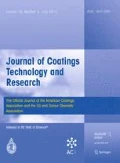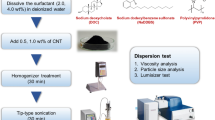Abstract
Factors that can affect the stability of waterborne polyurethane (WBPU)/clay nanocomposite dispersions are reported. It is suggested that the dispersion stability depends on the carboxyl acid salt content, clay content, sonication (mechanical forces), and clay surface structure. It was observed that the dispersion stability increased with increasing carboxyl acid salt content after applying sonication (mechanical forces) in clay with OH groups (Cloisite 30B) up to 23.58 mol% DMPA. Encapsulated (WBPU20-30B4-M and WBPU23-30B5-M) clay in PU particles was formed using the above combination. The dispersion with clay encapsulated in PU particles had the longest storage time of all of the dispersions. The zeta potential, particle size, particle size distribution, and viscosity of the dispersions also depend on carboxyl acid salt content, clay content, sonication (mechanical forces), and clay surface structure.







Similar content being viewed by others
References
Messersmith, P, Giannelis, EP, “Synthesis and Characterization of Layered Silicate-Epoxy Nanocomposites.” Chem. Mater., 6 1719–1725 (1994)
Lan, T, Pinnavaia, TJ, “Clay-Reinforced Epoxy Nanocomposites.” Chem. Mater., 6 2216–2219 (1994)
Kotal, M, Bhowmick, AK, “Polymer Nanocomposites from Modified Clays: Recent Advances and Challenges.” Prog. Polym. Sci., 51 127–187 (2015)
Lvov, Y, Abdullayev, E, “Functional Polymer–Clay Nanotube Composites with Sustained Release of Chemical Agents.” Prog. Polym. Sci., 38 1690–1719 (2013)
Abdullayev, E, Lvov, Y, “Clay Nanotubes for Corrosion Inhibitor Encapsulation: Release Control with End Stoppers.” J. Mater. Chem., 20 6681–6687 (2010)
Najafi, F, Bakhshandeh, E, Hadavand, BS, Saeb, MR, “Toward UV-Curable Urethane Acrylate/Silica Hybrid Coatings: Introducing Urethane Methacrylate Trimethoxysilane (UAMS) as Organic-Inorganic Coupling Agent.” Prog. Organ. Coat., 77 1957–1965 (2014)
Hwang, JJ, Liu, HJ, “Influence of Organophilic Clay on the Morphology, Plasticizer-Maintaining Ability, Dimensional Stability, and Electrochemical Properties of Gel Polyacrylonitrile (PAN) Nanocomposite Electrolytes.” Macromolecules, 35 7314–7319 (2002)
Chattopadhyay, DK, Raju, KVSN, “Structural Engineering of Polyurethane Coatings for High Performance Applications.” Prog. Polym. Sci., 32 352–418 (2007)
Lee, HT, Hwang, JJ, “Effects of Ionic Interactions Between Clay and Waterborne Polyurethanes on the Structure and Physical Properties of their Nanocomposite Dispersions.” J. Polym. Sci. A Polym. Chem., 44 5801–5807 (2006)
Lee, HT, Lin, LH, “Waterborne Polyurethane/Clay Nanocomposites: Novel Effects of the Clay and Its Interlayer Ions on the Morphology and Physical and Electrical Properties.” Macromolecules, 39 6133–6141 (2006)
Rahman, MM, “Improvements of Antimicrobial and Barrier Properties of Waterborne Polyurethane Containing Hydroxyapatite-Silver Nanoparticles.” J. Adhes. Sci. Technol., 31 613–626 (2017)
Kim, BK, Seo, JW, Jeong, HM, “Morphology and Properties of Waterborne Polyurethane/Clay Nanocomposites.” Eur. Polym. J., 39 85–91 (2003)
Rahman, MM, Yoo, HJ, Mi, CJ, Kim, HD, “Synthesis and Characterization of Waterborne Polyurethane/Clay Nanocomposite—Effect on Adhesive Strength.” Macromol. Symp., 249–250 251–258 (2006)
Chinwanticharoen, C, Kanoh, S, Yamada, T, Tada, K, Hayashi, S, Sugano, S, “Preparation and Shelf-Life Stability of Aqueous Polyurethane Dispersions.” Macromol. Symp., 216 229–239 (2004)
Deng, X, Liu, F, Luo, Y, Chen, Y, Jia, D, “Preparation, Structure and Properties of Comb-Branched Waterborne Polyurethane/OMMT Nanocomposites.” Prog. Organ. Coat., 60 11–16 (2007)
Huh, JH, Rahman, MM, Kim, HD, “Properties of Waterborne Polyurethane/Clay Nanocomposite Adhesive.” J. Adhes. Sci. Technol., 23 739–751 (2009)
Bhanvase, BA, Pinjari, DV, Gogate, PR, Sonawane, SH, Pandit, AB, “Synthesis of Exfoliated Poly(styrene-co-methyl methacrylate)/Montmorillonite Nanocomposite Using Ultrasound Assisted In Situ Emulsion Copolymerization.” Chem. Eng. J., 181–182 770–778 (2012)
Acknowledgments
This study was supported by Center of Research Excellence in Corrosion (CoRE-C), King Fahd University of Petroleum and Minerals (KFUPM), Dhahran 31261, Saudi Arabia.
Author information
Authors and Affiliations
Corresponding author
Rights and permissions
About this article
Cite this article
Rahman, M.M. Stability and properties of waterborne polyurethane/clay nanocomposite dispersions. J Coat Technol Res 14, 1357–1368 (2017). https://doi.org/10.1007/s11998-017-9944-3
Published:
Issue Date:
DOI: https://doi.org/10.1007/s11998-017-9944-3




